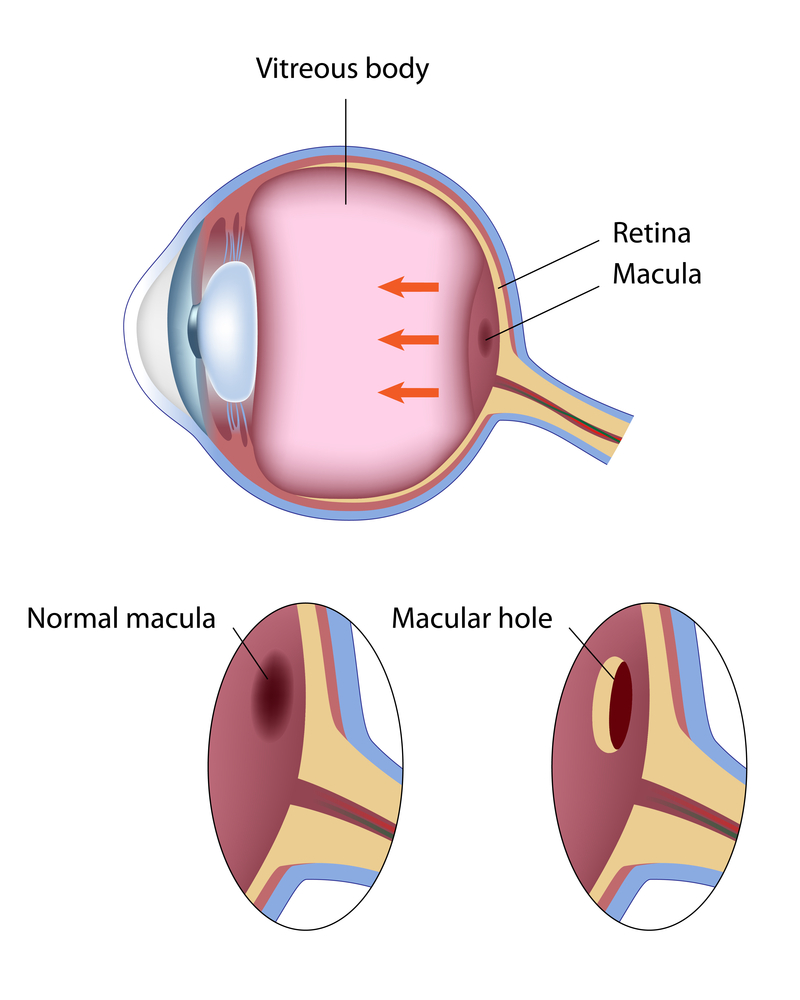Macular Edema
Macular edema is the swelling of the macula, which is the center part of the retina that gives us sharp reading vision. The accumulation of fluid causes visual distortion and blurred vision. There are various causes for macular edema, including diabetic retinopathy, retinal vein occlusion, uveitis (inflammation), age-related macular degeneration, and ocular surgery. This is the most common cause of vision loss in diabetics.

Macular Hole
A macular hole is a defect in the macula, which is the center part of the retina that gives us sharp reading vision. Macular holes usually develop as a result of the natural aging process and are known as idiopathic macular holes. These tend to occur primarily in people in their 60s to their 80s. Less commonly, macular holes can be caused by blunt trauma or seen in patients with retinal detachments or severe swelling of the retina. In the early stages of macular hole formation, the hole may only cause a small distortion of the central vision. As the macular hole progresses, the vision will worsen but will not cause complete blindness.
Macular Pucker
Epiretinal membrane (ERM) or macular pucker is the result of a semi-translucent membrane on the inner retinal surface. ERM can be idiopathic and is relatively common in patients over age 50, and both sexes are equally affected. Secondary ERM occurs regardless of age and sex due to inflammation, retinal tears/detachment, or bleeding in the vitreous.
Retinal Vein Occlusion
Retinal vein occlusion is a common vascular disorder of the retina. Obstruction of the retinal vein at the optic nerve is referred to as central retinal vein occlusion (CRVO) and obstruction at a branch of the retinal vein is referred to as a branch retinal vein occlusion (BRVO).
Most retinal vein occlusions occur after the age of 50, younger patients with retinal vein occlusion may be asked to see their internist for a thorough medical evaluation.
Branch Retinal Vein Occlusion
The symptoms of a branch retinal vein occlusion depend on which venous branch is involved. Blurred vision is a common symptom that results from macular edema (swelling in the retina). If the branch retinal vein occlusion occurs at a portion of the retina away from the central vision then it may be asymptomatic.
Central Retinal Vein Occlusion
When the central retinal vein is blocked, this will result in more blood and swelling building up in the retina and also worse vision than a branch retinal vein occlusion. Blurred vision is usually due to macular edema or glaucoma from abnormal blood vessels that develop in the eye.
Diagnosis
A dilated eye examination is usually followed by a fluorescein angiography and optical coherence tomography.
Treatment
One of the main complications of vein occlusion is macular edema, which is swelling in the central part of the retina. Injections of anti-vascular endothelial growth factors and steroids may help treat macular edema.
In severe cases of central retinal vein occlusion, abnormal blood vessels may develop in the eye. Laser treatment is needed and sometimes vitrectomy surgery or glaucoma surgery may be necessary if the problem becomes more severe.
Most retinal vein occlusions occur after the age of 50, younger patients with retinal vein occlusion may be asked to see their internist for a thorough medical evaluation.
Central Serous Retinopathy
Central serous retinopathy (CSR), also known as central serous chorioretinopathy (CSC), is an eye condition that causes visual distortion, due to the accumulation of fluid underneath the retina. More men, in their 20 to 50s, are affected by this condition than women.
